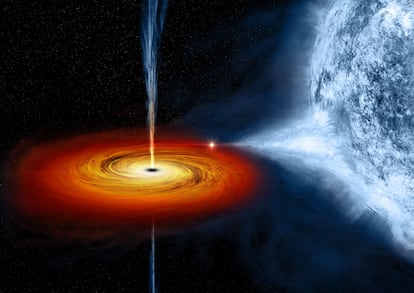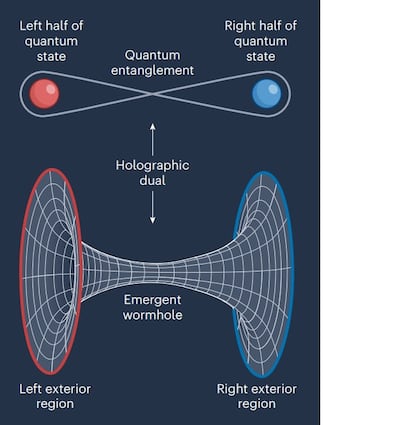First simulation of a wormhole opens new door to understanding the universe
Scientists transmit a message through a space-time tunnel and achieve a breakthrough in quantum mechanics

Quantum mechanics and the theory of relativity are like Cain and Abel – two mismatched siblings with the same nature. One is focused on matter at subatomic scales, and the other examines the macroscopic world. The two theories are incompatible, so finding a point of reconciliation is fundamental to understanding physical reality. Yet an article in Nature reports that an initial rapprochement was recently achieved with the first quantum simulation of a wormhole using the Google Sycamore processor. Maria Spiropulo, a physicist at the California Institute of Technology (Caltech) and one of the authors of the Nature article, says that this experiment demonstrates “that the properties of a quantum system correlate with those of a gravitational system.” This finding is a significant leap forward for the study of black holes and laboratory research on the hypothesis of quantum gravity using computers that can harness the phenomena of quantum mechanics. A new door to understanding the universe has been opened.
A wormhole, also known as an Einstein-Rosen bridge, represents a shortcut through space and time, a type of shortened tunnel between two galaxies that are actually light years apart. Scientists have theoretically demonstrated that this shortcut can be generated by creating two entangled black holes. A wormhole can be illustrated as two funnels joined at the narrow ends, with black holes situated at the wide mouths.
But unlike the wormholes in science fiction movies, they cannot transmit information or teleport matter because any message or object that goes in never reaches the other end. As the wormhole expands and contracts, anything trapped inside is annihilated. This destruction is typical of black holes, which don’t even allow light to pass through. However, if a conventional interaction (transmitted at the speed of light) is established between two observers at opposite ends of the wormhole, it will open up in a manner that allows it to be traversed.
This phenomenon cannot be observed by conducting experiments, since there is no viable way of creating two entangled black holes in a laboratory. Therefore, the researchers that published the paper in Nature created and studied a “holographic equivalent” of this process.
Alberto Casas, a research fellow at the Institute of Theoretical Physics in Madrid and the author of La revolución cuántica (or, The Quantum Revolution), explained the concept of the wormhole simulation in simple terms. “It’s like a cylindrical can. Inside there are three dimensions, but the ends are two-dimensional – flat. The gravitational force acting on everything inside produces a reflection that can be seen on the two lids of the can where there is no gravity.” This is called the holographic principle, says Casas, a principle that is presumably fulfilled in a consistent quantum gravity theory. “Everything that happens in a gravitational theory has an equivalent in a non-gravitational theory, but with one less dimension,” said Casas. Specifically, the wormhole in the gravitational theory would be seen as a quantum entangled system in the non-gravitational theory. Therefore, transmitting information through a wormhole could be perceived as quantum teleportation in the non-gravitational theory.
“The authors [of the Nature article] have created an entangled system between two parts of a quantum computer that has a wormhole as a holographic equivalent. And they demonstrated that information can be transmitted between these two parts through a kind of quantum teleportation, mimicking exactly what would happen through the equivalent wormhole,” said Casas.

It’s a striking phenomenon to observe since the message written by Alice (the name used in quantum physics for the message sender) seems to be irretrievably lost somewhere in the first subsystem, but then it reappears intact shortly afterwards in Bob’s (the message recipient) subsystem. “It’s as if Alice wrote a message on water,” said Casas. “At first the message seems to disappear in the movements of trillions of water molecules, and is impossible to retrieve. But then the message reappears intact at another point on the water’s surface. This surprising behavior is what actually happens between the two entangled systems created in this experiment. It may be more easily understood if we think of its holographic equivalent: Alice’s message is swallowed by the wormhole and delivered to Bob at the other end.”
“It’s a very interesting result,” said Casas, “because if a more powerful computer is used [only nine qubits were used in the simulation], one could simulate macroscopic systems and study the effects of quantum gravity on them.” The authors of the Nature article acknowledge that the simulation could have been achieved using conventional computing, but the use of Google’s Sycamore computer demonstrates the potential of performing quantum gravity experiments on processors based on quantum physics.
Ignacio Cirac, director of the Theory Division of the Max-Planck Institute for Quantum Optics (Garching, Germany), also recognizes this potential. “Existing quantum computer prototypes and those that will be developed in the near future may become a key tool for addressing fundamental questions. This experiment is still very basic, but it’s an important step forward. Simulations can provide information on how black holes behave, especially when we study them from the perspective of quantum physics,” Cirac told the Science Media Center (SMC).
Carlos Sabín, a researcher in theoretical physics at the Autonomous University of Madrid, says that it’s important to understand that no wormhole was actually created in this experiment. “We are talking about an analogy,” he said to the SMC. But he noted another valuable contribution of the experiment: “A dictionary that translates what happens to the real qubit into the language of what would happen to the simulated or virtual qubit… The authors introduce techniques that show how the experiment could be efficiently extended to a higher number of qubits, so an experiment that exceeds the capabilities of a conventional computer could be performed using quantum computers with lower error probabilities, which we expect to have in the next few years. In any case, this experiment shows that, even with just a few qubits and current error probabilities, quantum computers can already do interesting things.”
Adam R. Brown and Leonard Susskind, two professors of theoretical physics at Stanford University (California) who also collaborate with Google’s quantum computing division, published a second article in Nature that describes the holographic principle as “a guide in our quest to understand how to combine the two most celebrated theories of modern physics – quantum mechanics and general relativity.” The two physicists also highlight the importance of information transmission: “In the non-gravitational description, the appearance of the uncoded message elsewhere is an unambiguous prediction of quantum mechanics, but it is somewhat mysterious. The surprise is not that the message somehow arrived, but that it arrived undeciphered. However, this is easily understood from the gravitational description: the message arrives undeciphered on the other side because it has gone through the wormhole.”
“In the future,” write Brown and Susskind, “we might expect that quantum communication techniques will be invented that are too difficult to analyze using conventional means, but which use holographic duality as a powerful tool for analysis and discovery.”









































